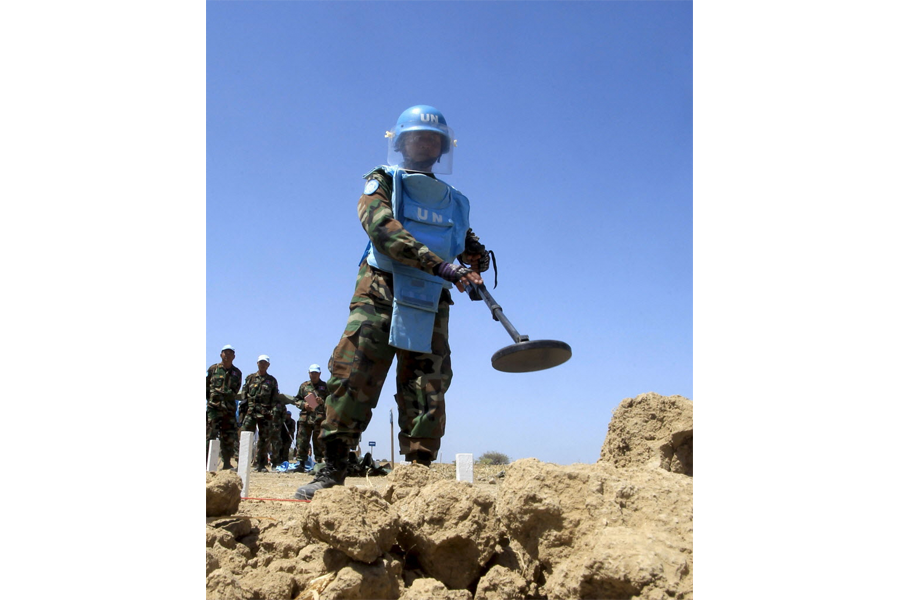Land mines could be almost completely gone within a decade, experts say
Loading...
For more than a century, land mines have been among the most insidious tools of war – hidden, indiscriminate killers that lurk long after the formal conclusion of a violent conflict.
But that era may be coming to an end. After 15 years of global effort, experts say the world now stands to be nearly mine-free within a decade. And while there still remain mine fields to be cleared in dozens of countries, land mines have already conclusively lost one fight: legitimacy.
“Now every time a state uses land mines there’s basically global condemnation of their actions,” says Kathryn Millett, a mine-action coordinator with Landmine and Cluster Munition Monitor, which tracks global progress in de-mining. “The stigma has become almost immeasurable.”
The tide first began to turn against land mine use in 1997, when 122 countries signed the Mine Ban Treaty – pledging to destroy their stockpiles and clear all mine fields within their borders. Since then, 39 more countries have signed.
A total of 87 countries have since destroyed more than 47 million mines, according to Landmine Monitor, and with minor fluctuations, the number of land-mine casualties has decreased nearly every year, reaching its lowest recorded point in 2013. “The treaty really created and now upholds a norm,” Ms. Millett says. “We’ve seen progress every day for the last 15 years.”
Last year Bhutan, Hungary, and Venezuela completed clearance of all known minefields, while Burundi and Montenegro became mine-free earlier this year, joining 19 other states that have declared themselves free of mines since 1999.
Meanwhile, Mozambique, which was one of the most heavily mined countries in the world from the 1970s to the 1990s, is on track to complete mine clearance by the end of this year.
Mozambique is also the site of perhaps the world’s most unusual de-mining operation. It uses trained African giant pouched rats to detect land mines. The operation, run by the Belgian nongovernmental organization Apopo, says that a rat can process 100 square meters of mine field in 20 minutes, an area that would take a person an entire day to clear. Apopo now runs a similar rat de-mining operation in Angola.
Globally, however, there remain spots of major concern. Sixty countries and territories still have mined areas, and several large countries – including the United States – have not signed the Mine Ban Treaty. (The Obama administration announced in June, however, that it plans to work gradually toward joining the treaty.)
Meanwhile, 29 signatories to the treaty have asked for an extension in clearing their mine fields or destroying stockpiles, and still half are not on track to finish by deadline. Afghanistan and Cambodia – the world’s most mine-contaminated countries – still record dozens of casualties monthly.
And Bosnia-Herzegovina, which had promised to clear all of the mines sowed during its 1990s civil war by 2019, hit a major snag this year when massive floods swept across mine-contaminated lands, dislodging an unknown number of the devices. The United Nations Development Program estimates the floods will set back the country’s de-mining efforts by at least a year.
“Huge progress was made globally in the last 15 years, but I think the next 15 years will be the real struggle,” says Abigail Hartley, the chief of policy and public information for the UN Mine Action Service. “In many places the emergency and the sense of imminent threat have been removed, and the mines that remain are not always a major priority.”
A country’s final mines are often far-flung, and de-mining has to compete with other development priorities – education, health, infrastructure – for funding and attention. “We call them the million-dollar mines,” Ms. Hartley says, “and you have to ask, at what point do you stop looking for them when your country has other needs...?”
Still, in June the International Campaign to Ban Landmines called on every country on the Mine Ban Treaty roster to complete its de-mining efforts by 2025 – a goal that experts say is largely feasible.
“I’m optimistic about de-mining progress, but as long as there are still mines in the ground, there’s work to be done,” says Kjersti Tokle Fjellhaug, a mine-action adviser for Apopo. “The aim is zero victims. It doesn’t make sense to scale down efforts to achieve a mine-free world until the moment a mine-free world is achieved.”








